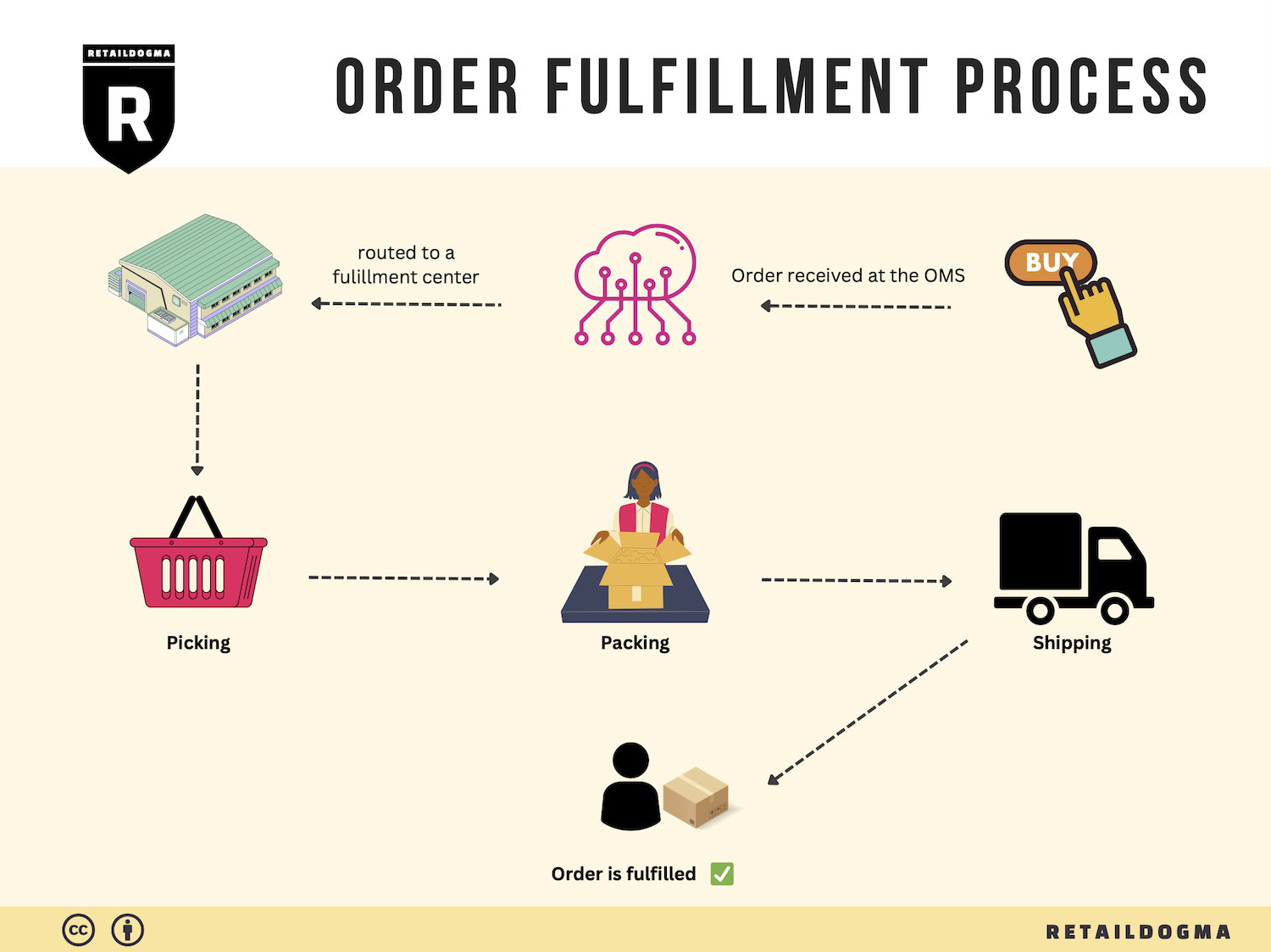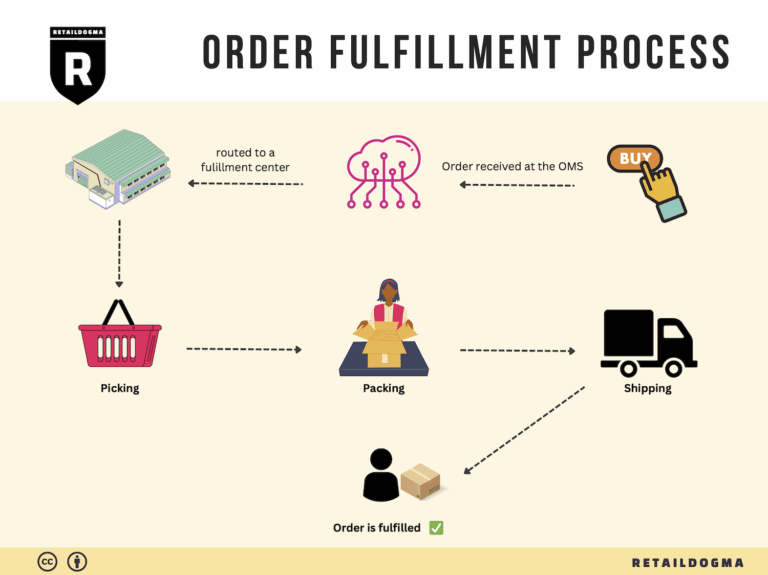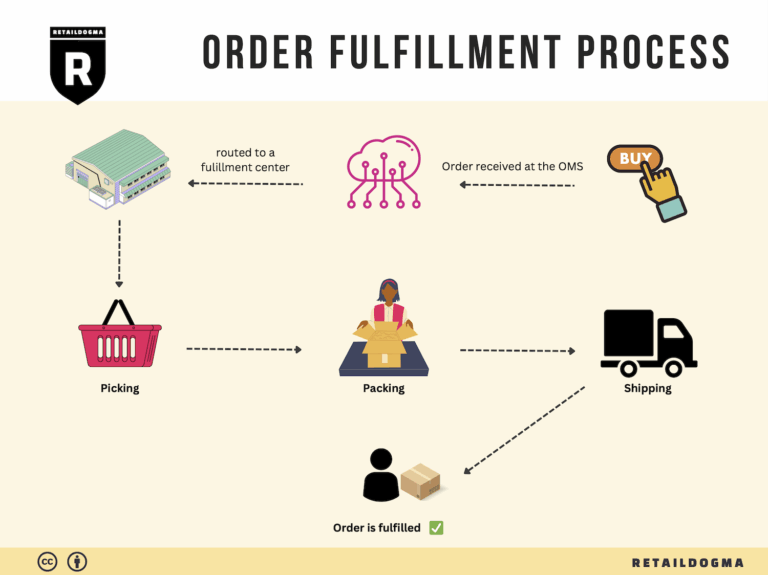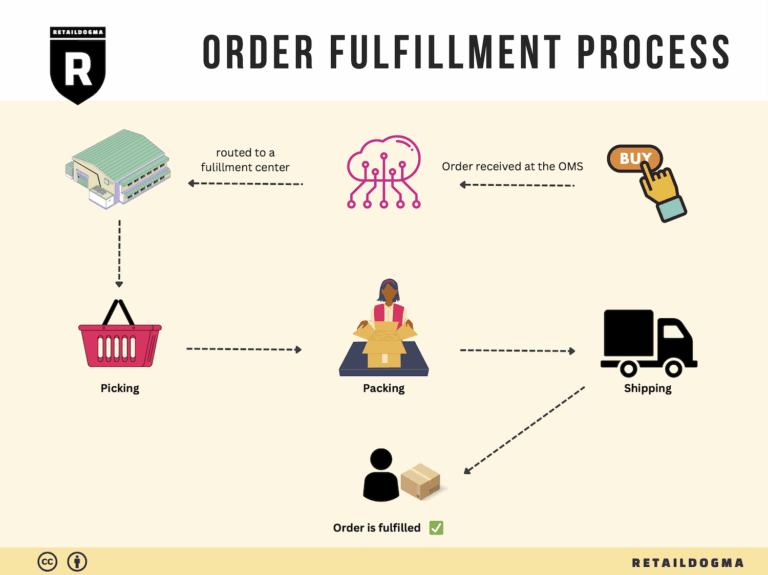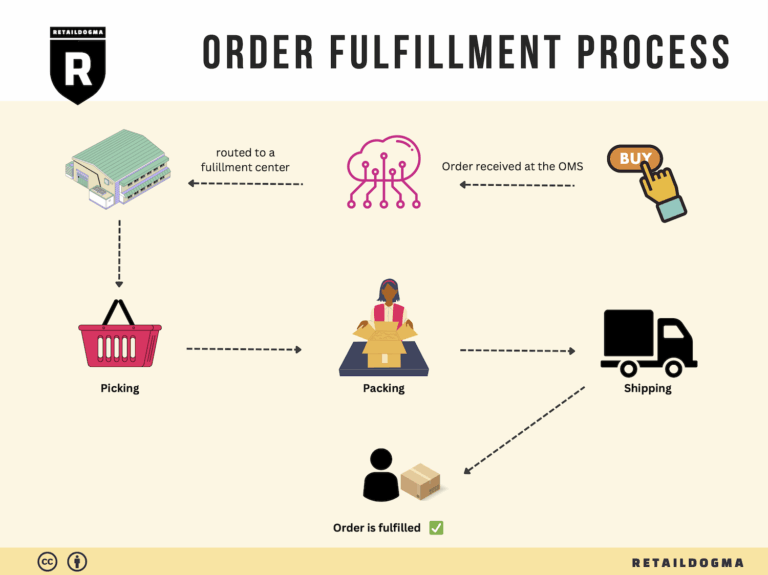What Is A Fulfillment Center? A Complete Guide (2025)
What is E-commerce Fulfillment? An Introduction for Growing Businesses
Navigating the Challenges of E-commerce Fulfillment
As your online business begins to grow, you may find yourself overwhelmed by the sheer volume of orders that need to be packed and shipped. The excitement of increased sales can quickly turn into stress as you juggle inventory management, order processing, and logistics. This is where an effective e-commerce fulfillment strategy becomes essential.
E-commerce fulfillment is fundamentally the process of getting a product from your store to your customer’s doorstep. It encompasses various activities including inventory management, order picking, packing, shipping, and handling returns. For many growing businesses, the decision on how to manage these tasks can be daunting. Should you handle fulfillment in-house, or is it time to consider outsourcing to a fulfillment partner?
In this guide, we will explore the different fulfillment models available to e-commerce businesses. You’ll learn about third-party logistics (3PL) providers, which take on the heavy lifting of storage, packing, and shipping on your behalf, as well as popular options like Fulfillment by Amazon (FBA), which leverages Amazon’s extensive network for rapid delivery. Each model has its own set of advantages and considerations, and understanding these can help you make informed choices as your business scales.
We will also delve into the core services that fulfillment partners typically offer, such as inventory management, order tracking, and returns handling. Knowing what services are available can help you identify which fulfillment partner aligns best with your operational needs and customer expectations.
Choosing the right fulfillment partner is a critical decision that can significantly impact your business’s efficiency and customer satisfaction. This guide will provide you with practical tips on what to look for in a fulfillment provider, including factors like speed, reliability, and cost-effectiveness.
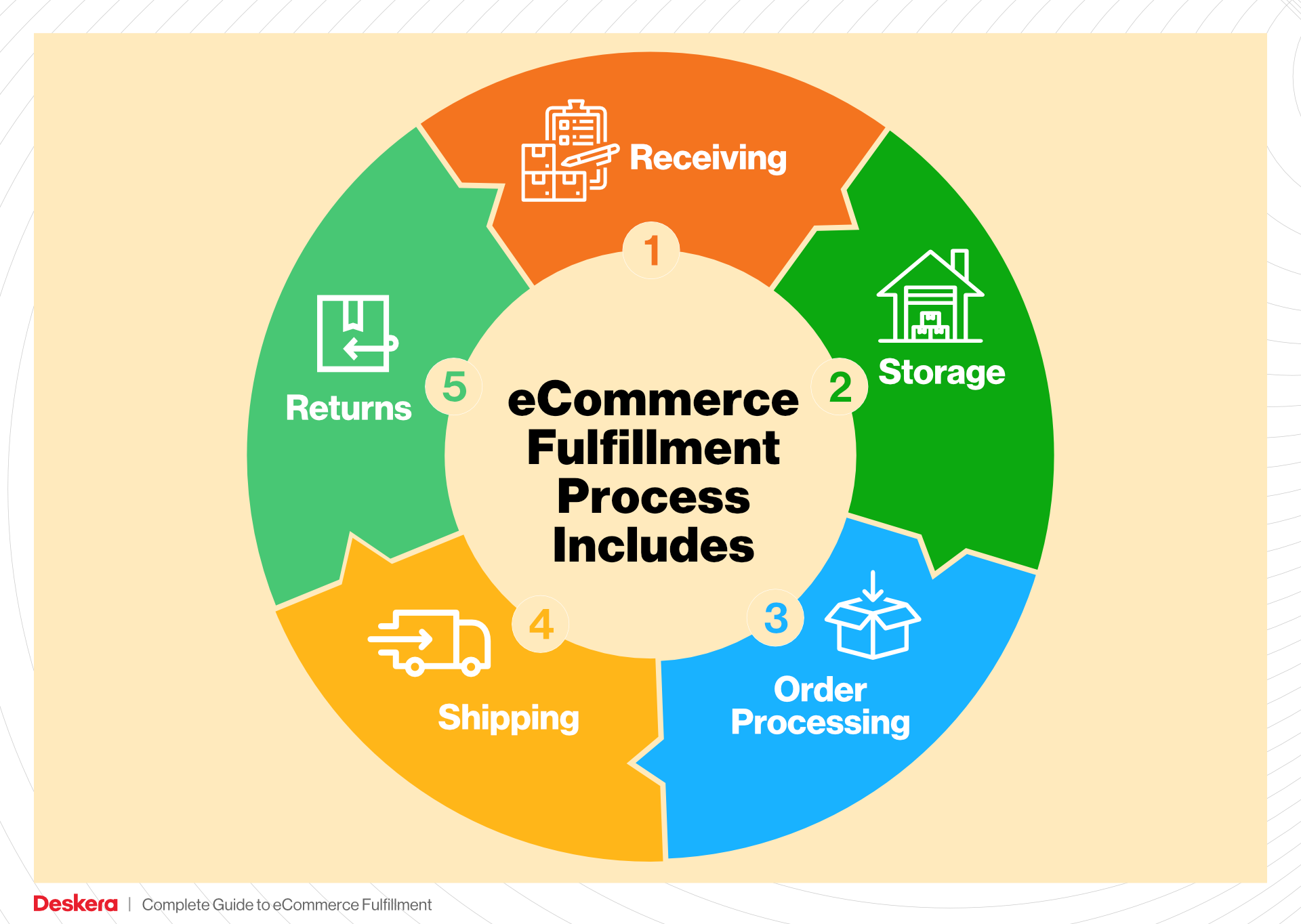
Finally, we’ll touch on pricing models for fulfillment services. Understanding the costs associated with different fulfillment options will empower you to budget effectively and make decisions that support your growth objectives.
Our goal is to equip you with the knowledge and tools necessary to navigate the complexities of e-commerce fulfillment confidently. By the end of this guide, you will be better positioned to make smart logistics decisions that enhance your customer experience and support your business’s growth trajectory.
What You’ll Learn In This Guide
- What is E-commerce Fulfillment? An Introduction for Growing Businesses
- The Order Fulfillment Process: From ‘Buy’ Button to Customer’s Door
- Comparing Fulfillment Models: In-House vs. 3PL vs. Dropshipping
- A Deep Dive into Amazon FBA: Pros, Cons, and Who It’s For
- Core Services Offered by Fulfillment Centers
- How to Choose a Fulfillment Partner: A 6-Point Checklist
- Understanding Fulfillment Pricing: A Breakdown of Common Fees
- Frequently Asked Questions (FAQs) about Fulfillment
- Conclusion: Is Outsourcing Fulfillment the Right Move for Your Business?
- Important Disclaimer
The Order Fulfillment Process: From ‘Buy’ Button to Customer’s Door
1. Receiving Inventory
The first step in the order fulfillment process is receiving inventory. This involves the physical arrival of products from suppliers or manufacturers to your fulfillment center. During this phase, it’s essential to verify that the received items match the purchase orders in terms of quantity and specifications. A common practice here is to use Stock Keeping Units (SKUs), which are unique identifiers for each product.
Why is this step crucial? Accurate inventory receiving helps prevent stock discrepancies, which can lead to order fulfillment delays and customer dissatisfaction. Additionally, it sets the foundation for effective inventory management, ensuring that your stock levels are up-to-date and reflective of actual available products. Implementing an efficient receiving process can significantly reduce operational costs and improve overall supply chain efficiency.
2. Warehouse Storage
Once the inventory is received, the next step is warehouse storage. This involves organizing and storing the products in a manner that maximizes space and facilitates easy access for future picking. Effective warehouse management systems (WMS) play a vital role in this phase by tracking inventory locations and ensuring that items are stored optimally based on their demand and turnover rates.
The importance of this step lies in its direct impact on order fulfillment speed and accuracy. Well-organized storage reduces the time it takes to locate and retrieve products, which is critical in meeting customer expectations for fast shipping. Additionally, implementing a systematic storage solution, such as the ABC analysis method, can help prioritize inventory based on value and demand, further enhancing operational efficiency.
3. Order Picking
The third step in the order fulfillment process is order picking, where warehouse staff retrieve items from storage to fulfill customer orders. This process typically involves using pick lists—documents or digital tools that specify which items and quantities need to be collected for each order.
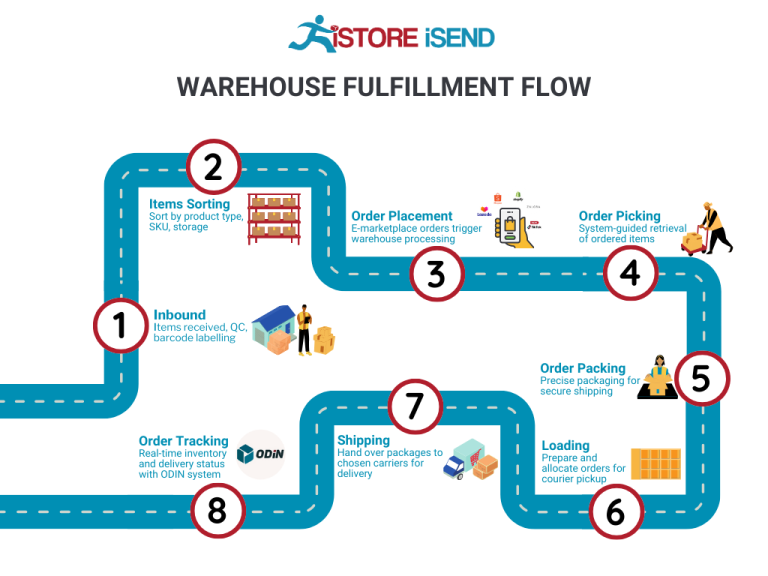
Order picking is a pivotal phase because it directly influences the accuracy and speed of fulfillment. Errors in this stage can lead to incorrect shipments, resulting in customer dissatisfaction and increased return rates. Therefore, investing in technologies like barcode scanning or pick-to-light systems can enhance picking accuracy and efficiency. By streamlining this process, businesses can significantly reduce lead times and improve customer satisfaction.
4. Order Packing
Once the items are picked, the next step is order packing. This involves preparing the products for shipment by placing them in appropriate packaging, ensuring they are protected during transit. Key considerations in this phase include selecting the right packing materials, applying shipping labels, and including any necessary documentation, such as invoices or return instructions.
The packing process is vital for maintaining product integrity and enhancing customer experience. Well-packed orders reduce the risk of damage during shipping, which can result in costly replacements and unhappy customers. Additionally, efficient packing can help minimize shipping costs by optimizing package dimensions and weight. Utilizing technology, such as automated packing systems, can further improve packing speed and accuracy, allowing businesses to scale operations effectively.
5. Shipping & Delivery
The final step in the order fulfillment process is shipping and delivery. This phase encompasses the logistics of transporting the packed orders to the customer’s designated address. It involves selecting the right carrier, determining shipping methods (e.g., standard, expedited), and tracking the shipment until it reaches the customer.
Shipping and delivery are critical components of the customer experience, as timely delivery can greatly influence customer satisfaction and loyalty. Utilizing shipping management software can streamline this process by comparing rates from various carriers, automating label generation, and providing real-time tracking updates to customers. Additionally, offering multiple shipping options can cater to different customer preferences, enhancing their shopping experience and potentially leading to repeat business.

By understanding and optimizing each of these five steps in the order fulfillment process, e-commerce businesses can significantly enhance their operational efficiency, reduce costs, and ultimately drive customer satisfaction.
Comparing Fulfillment Models: In-House vs. 3PL vs. Dropshipping
Fulfillment Models Comparison
| Model | Who Handles Inventory | Best For (Business Stage) | Key Advantage | Key Disadvantage |
|---|---|---|---|---|
| In-House Fulfillment | The business itself | Startups and small businesses | Full control over inventory and processes | Labor and operational costs can be high |
| Third-Party Logistics (3PL) | An external logistics provider | Growing businesses | Scalable and cost-effective | Less control over the fulfillment process |
| Dropshipping | Supplier or manufacturer | New entrepreneurs and niche markets | Low upfront costs and inventory risk | Longer delivery times and less control over quality |
In-House Fulfillment
In-house fulfillment refers to the process where a business manages its own inventory, storage, packing, and shipping operations. This model is ideal for startups and small businesses that either have unique shipping requirements or want to maintain complete control over their fulfillment processes. By handling logistics internally, businesses can customize their packaging, provide personalized customer service, and quickly respond to changes in inventory levels. However, this model comes with its challenges. Labor costs, operational expenses, and the need for sufficient storage space can quickly add up, potentially limiting scalability as order volumes increase. Additionally, the responsibility of managing returns and exchanges falls entirely on the business, which can strain resources if not managed effectively.
Third-Party Logistics (3PL)
Third-party logistics (3PL) involves outsourcing fulfillment activities to an external provider. This model is suitable for growing businesses that are experiencing an increase in order volume but may not have the infrastructure or resources to manage fulfillment in-house. By partnering with a 3PL, businesses can benefit from the provider’s expertise in logistics, access to advanced technology, and economies of scale in shipping costs. This allows businesses to focus more on sales and marketing while the 3PL handles storage, packing, and shipping. However, a key disadvantage is the reduced control over the fulfillment process. Businesses must rely on their 3PL partner to maintain quality standards, manage inventory accurately, and ensure timely delivery. This can lead to potential discrepancies in service levels and customer satisfaction if the 3PL fails to meet expectations.
Dropshipping
Dropshipping is a fulfillment model where the retailer does not hold inventory but instead forwards customer orders directly to a manufacturer or supplier, who then ships the products directly to the customer. This model is particularly appealing for new entrepreneurs and those looking to test niche markets without the burden of upfront inventory costs. The primary advantage of dropshipping is the minimal financial risk; businesses can offer a wide range of products without the need to invest in inventory upfront. However, dropshipping does come with significant drawbacks, including longer delivery times and less control over product quality and customer service. Since the retailer is not handling the product directly, issues such as shipping delays or product defects can lead to customer dissatisfaction, which ultimately affects the retailer’s reputation. Additionally, profit margins in dropshipping can be lower compared to other models due to the reliance on suppliers for fulfillment.
In summary, each fulfillment model offers distinct advantages and disadvantages, making it crucial for e-commerce businesses to evaluate their specific needs, goals, and resources. Whether opting for in-house fulfillment for control, leveraging a 3PL for scalability, or using dropshipping to minimize risk, understanding these models will help businesses make informed decisions that align with their growth strategies.
A Deep Dive into Amazon FBA: Pros, Cons, and Who It’s For
What is Fulfillment by Amazon (FBA)?
Fulfillment by Amazon (FBA) is a service offered by Amazon that allows sellers to store their products in Amazon’s fulfillment centers. Amazon then takes care of storage, packaging, shipping, and customer service on behalf of the sellers. This service provides a seamless way for e-commerce businesses to leverage Amazon’s vast logistics network and customer base.
When a customer places an order for a product fulfilled by FBA, Amazon picks, packs, and ships the product directly to the customer. Additionally, FBA sellers can benefit from Amazon’s customer service and return handling, which adds a layer of convenience for both the seller and the buyer.
How Does FBA Work?
The process of using FBA involves several key steps:
-
Account Setup: Sellers need to create an Amazon seller account and enroll in FBA. This involves agreeing to Amazon’s terms and conditions for using the service.
-
Inventory Preparation: Sellers prepare their products for shipment to Amazon’s fulfillment centers. This includes labeling products according to Amazon’s specifications and ensuring that they meet packaging requirements.
-
Shipping to Amazon: Once the products are ready, sellers ship them to designated Amazon fulfillment centers. Amazon provides shipping guidelines to ensure that inventory arrives safely and efficiently.
-
Product Listing: Sellers list their products on Amazon, indicating that they are using FBA. This listing allows customers to see that the product is eligible for Prime shipping and other benefits.
-
Order Fulfillment: When a customer places an order, Amazon takes over. They pick the product from their inventory, pack it, and ship it to the customer.
-
Customer Service and Returns: Amazon handles customer service inquiries related to FBA orders, as well as managing returns, allowing sellers to focus on other aspects of their business.
Pros of Fulfillment by Amazon (FBA)
-
Prime Eligibility: One of the most significant advantages of FBA is that products become eligible for Amazon Prime. This can significantly increase sales, as Prime members often prefer products that can be delivered quickly and with free shipping.
-
Customer Trust: Leveraging Amazon’s brand reputation can help build trust with customers. Many shoppers feel more comfortable purchasing products that are fulfilled by Amazon due to their established customer service and return policies.
-
Multi-Channel Fulfillment: FBA allows sellers to fulfill orders from other sales channels, such as their own website or other marketplaces, using Amazon’s logistics. This means sellers can centralize their inventory management while reaching a broader audience.
-
Scalability: FBA provides a scalable solution for growing businesses. Sellers can increase their inventory without worrying about storage and fulfillment logistics, allowing them to focus on marketing and sales strategies.
-
Streamlined Operations: With Amazon handling storage, packing, shipping, and customer service, sellers can save time and resources. This enables them to concentrate on product development and business growth rather than logistics.
Cons of Fulfillment by Amazon (FBA)
-
High Fees: FBA can be costly, especially for small businesses. Amazon charges various fees for storage, fulfillment, and optional services, which can eat into profit margins. Sellers need to carefully calculate whether the benefits outweigh the costs.
-
Strict Inventory Rules: Amazon has stringent inventory management rules, including limits on how much inventory sellers can store in their fulfillment centers. This can pose challenges for sellers with fluctuating demand or seasonal products.
-
Commingling Risks: When using FBA, sellers’ products may be commingled with those of other sellers. This means that if one seller’s product is defective or damaged, it could potentially impact the reputation of others. Additionally, tracking inventory can become complex.
-
Loss of Control Over Shipping: While Amazon’s logistics network is efficient, sellers may feel a loss of control over the shipping process. This can be particularly concerning for those who prioritize specific packaging or branding requirements.
-
Dependency on Amazon: Relying heavily on FBA can create dependency on Amazon’s platform. Any changes in Amazon’s policies, fees, or algorithms can directly impact a seller’s business operations and profitability.
Who is FBA Best For?
FBA is ideal for various types of e-commerce businesses, particularly those looking to scale quickly and efficiently. Here are some specific scenarios where FBA shines:
-
Startups and Small Businesses: New sellers can benefit from Amazon’s established infrastructure and customer trust, allowing them to enter the market without heavy upfront investments in logistics.
-
Brands with High Sales Volume: Established businesses with a consistent sales volume can leverage FBA to streamline operations, reduce overhead, and enhance customer experience.
-
Sellers with Seasonal Products: Businesses that experience seasonal spikes in demand can utilize FBA to manage logistics without committing to long-term warehousing solutions.
-
Multi-Channel Sellers: Brands selling on various platforms can benefit from FBA’s multi-channel fulfillment option, allowing for centralized inventory management while reaching customers on different sales channels.
In conclusion, Fulfillment by Amazon offers a robust solution for e-commerce businesses aiming to enhance their logistics capabilities and customer service. While it presents challenges, the benefits can far outweigh the drawbacks for many sellers, particularly those looking to scale their operations and tap into Amazon’s vast marketplace.
Core Services Offered by Fulfillment Centers
Inventory Management & Warehousing
Inventory management and warehousing are foundational services provided by fulfillment centers, designed to streamline the storage and handling of products for e-commerce businesses. Fulfillment centers maintain large warehouses strategically located to minimize shipping times and costs. They utilize advanced inventory management systems that track stock levels in real-time, ensuring that businesses always have the right amount of product on hand without overstocking.
The benefits of effective inventory management are manifold. For one, it reduces the risk of stockouts, which can lead to lost sales and dissatisfied customers. By maintaining optimal stock levels, businesses can fulfill orders promptly, enhancing customer satisfaction and loyalty. Additionally, improved inventory tracking helps businesses analyze sales trends and adjust their purchasing strategies accordingly, leading to better cash flow management. This capability is particularly crucial during peak seasons or promotional periods when demand can fluctuate dramatically.
Pick and Pack Services
Pick and pack services are integral to the fulfillment process, involving the selection of ordered products (picking) and preparing them for shipment (packing). Once an order is placed, fulfillment center staff quickly locate the items in the warehouse, collect them, and package them securely for delivery. This process can be automated or manually executed, depending on the fulfillment center’s capabilities and the specific needs of the business.
The primary advantage of pick and pack services is the speed and efficiency they bring to order fulfillment. By outsourcing this task, e-commerce businesses can significantly reduce order processing times, which is critical in meeting customer expectations for fast delivery. Moreover, professional packing ensures that products are shipped safely, minimizing damage during transit and reducing the likelihood of returns. This service allows businesses to focus on their core competencies—like marketing and product development—while leaving the logistics to experts.
Kitting and Assembly
Kitting and assembly services involve the grouping of multiple products into a single package, often enhancing the appeal and functionality of the final product. For example, if a business sells a skincare line, a fulfillment center might create a kit that includes a cleanser, toner, and moisturizer. This process can also include assembly tasks, such as putting together furniture or creating gift baskets.
The benefits of kitting and assembly are significant for e-commerce businesses looking to increase average order values and improve customer experience. Bundling products can encourage customers to purchase more items at once, providing them with perceived value and convenience. Additionally, fulfillment centers that offer these services can streamline the process, ensuring that kits are assembled correctly and efficiently, thus reducing the time required to fulfill orders. This can be particularly advantageous during promotional events or holiday seasons when businesses want to capitalize on sales opportunities.
Returns Management (Reverse Logistics)
Returns management, also known as reverse logistics, is a crucial service offered by fulfillment centers, addressing the complexities of handling product returns. This process involves receiving returned items, inspecting them for damage, restocking them if possible, and managing any necessary repairs or refurbishments. Effective returns management is essential for maintaining customer satisfaction and loyalty, as it directly impacts the overall shopping experience.
The benefits of efficient returns management are twofold. First, it can enhance customer trust and satisfaction by making the return process seamless and straightforward. Customers are more likely to purchase from a business that has a clear and easy return policy. Second, effective returns handling can help businesses recover value from returned products, whether by restocking, refurbishing, or recycling items. This can significantly reduce losses associated with unsold inventory and contribute to a more sustainable business model.
In conclusion, the core services offered by fulfillment centers—inventory management and warehousing, pick and pack services, kitting and assembly, and returns management—are vital components for scaling e-commerce operations. By leveraging these services, businesses can improve efficiency, enhance customer satisfaction, and ultimately drive growth in a competitive marketplace.
How to Choose a Fulfillment Partner: A 6-Point Checklist
Location & Warehouse Network
Importance:
The geographical location of your fulfillment partner’s warehouses significantly impacts shipping speed and costs. Having fulfillment centers close to your customer base can reduce transit times and shipping expenses, ultimately enhancing customer satisfaction.
Questions to Ask:
– Where are your fulfillment centers located, and how many do you operate?
– How do you determine the best shipping routes for my products?
– Can you provide insights into your average shipping times to various regions?
Technology & Integrations
Importance:
A robust technology platform is essential for efficient order management, real-time tracking, and inventory management. Integrations with e-commerce platforms like Shopify can streamline operations and provide a seamless experience for both you and your customers.
Questions to Ask:
– What technology do you use for inventory and order management?
– Can your system integrate with my existing e-commerce platform (e.g., Shopify)?
– Do you offer real-time tracking for shipments, and how can I access this information?
Specializations (e.g., cold storage, oversized items)
Importance:
If your products require specific handling—such as cold storage for perishables or special equipment for oversized items—it’s crucial to partner with a fulfillment provider that has the necessary capabilities. This specialization ensures compliance with regulations and maintains product integrity.
Questions to Ask:
– Do you have experience handling products similar to mine (e.g., perishables, fragile items)?
– What specialized services do you offer, such as cold storage or hazardous materials handling?
– How do you ensure compliance with industry regulations for specialized products?
Scalability & Capacity
Importance:
As your business grows, your fulfillment needs will evolve. It’s important to choose a partner that can scale with you, whether you’re experiencing seasonal spikes or long-term growth. Understanding their capacity ensures they can meet your demands without compromising service.
Questions to Ask:
– What is your current capacity, and how do you plan to scale as my business grows?
– How do you handle peak seasons or sudden increases in order volume?
– Can you provide case studies or examples of how you’ve successfully scaled for other clients?
Pricing and Contracts
Importance:
Transparent pricing structures and flexible contracts are vital to ensure that your fulfillment costs align with your budget and business model. Understanding the terms of service can help you avoid unexpected charges and ensure a good return on investment.
Questions to Ask:
– What is included in your pricing model (e.g., storage, pick and pack, shipping)?
– Are there any additional fees I should be aware of (e.g., for returns, packaging, or handling)?
– What is the length of your contracts, and do you offer flexibility to adjust terms based on my needs?
Customer Support & Reviews
Importance:
Responsive and knowledgeable customer support is essential for addressing issues quickly and maintaining smooth operations. Additionally, checking reviews and testimonials can provide insights into the partner’s reliability and service quality.
Questions to Ask:
– What kind of customer support do you offer (e.g., dedicated account manager, 24/7 support)?
– Can you provide references or case studies from current or past clients?
– How do you handle issues such as lost shipments or inventory discrepancies?
Conclusion
Choosing the right fulfillment partner is a critical decision that can significantly impact your e-commerce business’s efficiency and customer satisfaction. By using this checklist, you can systematically evaluate potential partners to ensure they align with your operational needs, growth plans, and customer expectations. Each of these factors plays a crucial role in the long-term success of your fulfillment strategy, so take the time to assess them thoroughly before making a decision.
Understanding Fulfillment Pricing: A Breakdown of Common Fees
Initial Setup Fees
Initial setup fees are typically charged by fulfillment providers when you first sign on to their services. These fees can cover a range of activities including account setup, system integration, and any necessary onboarding training. The amount can vary significantly depending on the complexity of your operations and the fulfillment provider’s processes.
For instance, some providers may charge a flat fee, while others might base their charges on the number of SKUs you plan to manage or the level of customization you require in your integration. It’s essential to clarify what is included in these fees—such as software access, training sessions, or ongoing support—as this can affect the total cost of your fulfillment operations.
Receiving Fees
Receiving fees are incurred when the fulfillment center accepts your inventory. This fee generally covers the labor and resources needed to unload, inspect, and log your products into the system.
Receiving fees can be calculated in different ways:
– Per Pallet: Some providers charge a flat rate per pallet received.
– Per Item: Others might charge based on the number of individual items processed.
– Hourly Rates: In certain cases, providers may charge hourly for the time it takes to receive and check in inventory.
Understanding how receiving fees are structured can help you better predict costs, especially if you frequently send large shipments of inventory.
Storage Fees (per pallet/bin)
Storage fees are charged for the space your inventory occupies in the fulfillment center. These fees can be calculated based on the following metrics:
– Per Pallet: A common pricing model where you pay for each pallet your products occupy.
– Per Bin: Some fulfillment centers use bins or shelving units to store items, charging based on the number of bins used.
– Monthly Charges: Storage fees are typically billed on a monthly basis, and some providers may offer tiered pricing based on the volume of inventory stored.
It’s important to note that storage fees can vary based on the time of year; for example, many providers implement higher fees during peak seasons, such as the holiday shopping period. Planning for these fluctuations can help you manage your cash flow effectively.
Pick & Pack Fees (per item/order)
Pick and pack fees cover the labor involved in selecting items from storage and packaging them for shipment. This fee is crucial for understanding the overall cost of fulfilling an order. Providers often calculate pick and pack fees in one of the following ways:
– Per Item: A fee charged for each item picked and packed, which can incentivize efficient inventory management.
– Per Order: Some providers may charge a flat fee for each order, regardless of the number of items included.
Additional costs may apply for special packaging or handling requirements, such as fragile items or custom gift wrapping. Knowing the specifics of pick and pack fees will help you accurately estimate fulfillment costs as your order volume grows.
Shipping Fees
Shipping fees are one of the most variable costs in e-commerce fulfillment, influenced by multiple factors including:
– Carrier Rates: Different carriers have varying rates based on the shipping speed, distance, and package weight.
– Dimensional Weight: Many carriers calculate shipping costs based on the dimensional weight of a package, which can lead to higher charges for larger, lighter items.
– Service Levels: Expedited shipping options (like two-day delivery) will incur higher fees compared to standard shipping.
Fulfillment providers often negotiate discounted shipping rates with carriers, which can benefit merchants. Understanding these shipping dynamics can help you choose the best carrier and service level for your business needs.
Tips for Getting an Accurate Quote
-
Provide Detailed Information: When seeking quotes, provide potential fulfillment partners with comprehensive details about your product types, order volumes, and shipping requirements. The more information you provide, the more accurate your quote will be.
-
Ask About Hidden Fees: Inquire about any additional or hidden fees that may apply, such as for returns processing, special handling, or peak season surcharges.
-
Compare Multiple Providers: Don’t settle for the first quote you receive. Comparing multiple fulfillment providers can help you identify the most competitive pricing structures and service offerings.
-
Request a Breakdown: Ask for a detailed breakdown of all fees involved in the fulfillment process. This transparency will help you understand where your costs are coming from and identify potential areas for savings.
-
Evaluate Service Levels: Consider not just the price, but also the service levels offered. A slightly higher fee might be worth it if it means faster shipping or better customer service.
By understanding these common fulfillment pricing models and following these tips, you can make informed decisions that align with your business’s scaling goals.
Frequently Asked Questions (FAQs) about Fulfillment
1. What is Shopify Fulfillment?
Shopify Fulfillment refers to the process of managing inventory, packing, and shipping orders placed through a Shopify store. It can involve self-fulfillment, where the merchant handles all aspects of order delivery, or using third-party logistics (3PL) providers to streamline operations and improve efficiency.
2. How does the Shopify Fulfillment Network work?
The Shopify Fulfillment Network (SFN) connects Shopify merchants with trusted fulfillment partners like Flexport. Merchants send their inventory to a single fulfillment center, and when orders are placed, these partners handle the packing and shipping, allowing for faster and more reliable delivery.
3. What’s the difference between a warehouse and a fulfillment center?
A warehouse is primarily used for storing goods and inventory, while a fulfillment center is designed specifically for processing orders, packing products, and shipping them to customers. Fulfillment centers are strategically located to ensure quicker delivery times and often include value-added services like returns management.
4. What is a 3PL (Third-Party Logistics)?
A 3PL is a service provider that manages logistics and fulfillment for businesses. This includes warehousing, inventory management, order processing, and shipping. By outsourcing these functions to a 3PL, businesses can focus on core activities such as marketing and product development, while benefiting from the expertise and efficiency of logistics specialists.
5. How much do fulfillment services cost?
Fulfillment service costs can vary widely based on several factors, including order volume, storage space, shipping distances, and specific services offered. Generally, costs may include a per-order fee, storage fees based on the space your inventory occupies, and shipping costs. It’s advisable to request quotes from multiple providers to compare pricing.
6. What are the benefits of using a fulfillment service?
Using a fulfillment service can lead to faster shipping times, reduced operational costs, improved inventory management, and enhanced customer satisfaction. By outsourcing fulfillment, businesses can scale operations more effectively without the need for significant upfront investments in warehousing and logistics.
7. How do I choose the right fulfillment partner?
When selecting a fulfillment partner, consider factors such as their location, shipping capabilities, technology integration (like compatibility with Shopify), pricing structure, and customer service reputation. Look for a provider that aligns with your specific needs, whether that’s speed, cost-effectiveness, or specialized handling of certain product types.
8. Can I fulfill orders internationally with Shopify?
Yes, Shopify supports international fulfillment through various third-party logistics providers. However, it’s crucial to understand international shipping regulations, tariffs, and customs requirements that may affect delivery times and costs when shipping globally.
9. What is dropshipping, and how does it relate to fulfillment?
Dropshipping is an e-commerce model where the retailer does not keep products in stock but instead forwards customer orders to a supplier or manufacturer, who then ships the products directly to the customer. This method minimizes inventory risk but can lead to longer shipping times and less control over fulfillment quality.
10. How can I track my fulfillment process?
Most fulfillment providers offer integrated software solutions that allow you to track inventory levels, order processing, and shipping statuses in real-time. With Shopify, you can monitor these metrics directly through your admin dashboard, ensuring you stay informed about your order fulfillment performance and can make necessary adjustments.
Conclusion: Is Outsourcing Fulfillment the Right Move for Your Business?
Evaluating the Benefits of Outsourcing Fulfillment
Outsourcing fulfillment can be a game-changer for e-commerce businesses looking to scale efficiently. By partnering with a fulfillment service, you can save valuable time that would otherwise be spent managing inventory, packing, and shipping. This allows you to focus on core business activities such as marketing, product development, and customer engagement, ultimately driving growth.
Scalability is another significant advantage. As your order volume increases, a fulfillment partner can effortlessly adapt to your changing needs without the need for additional infrastructure or workforce investments. Many fulfillment services offer flexible solutions that can grow alongside your business, ensuring that you can meet customer demands without compromising service quality.
Moreover, leveraging the expertise of a fulfillment provider can enhance your operational efficiency. These partners bring specialized knowledge in logistics, shipping, and inventory management, which can help streamline your processes and reduce costs. With access to advanced technology and established carrier relationships, fulfillment companies can offer competitive shipping rates and faster delivery times, improving customer satisfaction.
However, choosing the right fulfillment partner is crucial for long-term success. Not all providers are created equal, and the wrong choice can lead to fulfillment issues that harm your reputation. It’s essential to assess potential partners based on their experience, technology, reliability, and customer service capabilities.
Take Action Now
As you contemplate the future of your business, consider conducting an audit of your current shipping and fulfillment processes. Identify pain points, inefficiencies, and areas where you could benefit from external support. This exercise will help you determine if outsourcing fulfillment is the right next step for your business. Remember, the right fulfillment partner can not only streamline your operations but also position your brand for sustainable growth in an increasingly competitive e-commerce landscape.
Important Disclaimer
⚠️ Important Disclaimer
The information in this guide is for educational purposes. Fulfillment services, pricing, and platform features change frequently. Always conduct your own due diligence and consult with providers directly before making business decisions.
